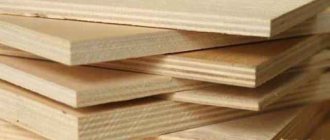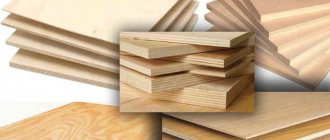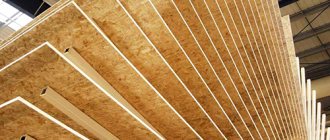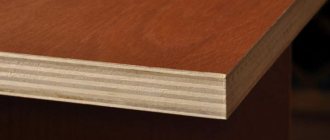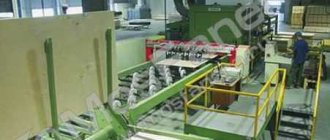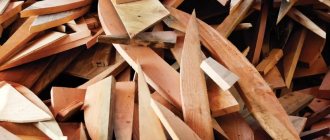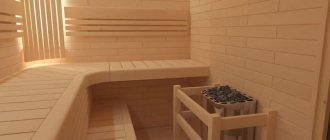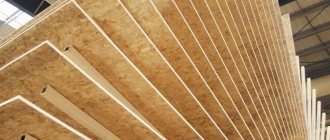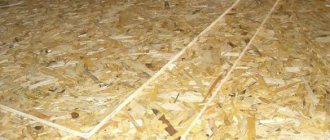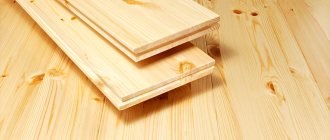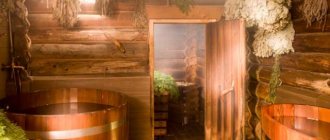Plywood is a durable, multi-layer material made from natural wood. The physical and mechanical properties and technical characteristics of plywood are determined by the process of its production itself. Namely, an odd number of sheets of thin wood veneer are glued together using glue.
The veneer sheets are arranged in such a way that the direction of the wood fibers is perpendicular to each other. This makes the plywood very resistant to breaking, stretching and chipping (see table below).
Due to these parameters and affordable cost, plywood flooring is often used in construction.
Plywood for floor
Bending strength of plywood
Bending strength of plywood (birch, coniferous and combined)
Specification for plywood - table
Birch, coniferous, laminated and combined (TU 5512-001-44769167-02 and TU 5512-002-44769167-98).
Specification for softwood plywood
Specification for laminated plywood
Specification for composite plywood
Birch plywood specification
It should be noted that due to the fact that plywood for a long time remained almost the only material available to our compatriots, it was used everywhere. This, in turn, led to the emergence of different types and types of plywood.
Types of plywood
Plywood is divided into types based on its scope of application: construction, furniture, structural, industrial, packaging.
The type of plywood is determined based on the glue used during production:
- FC is a water-repellent type of plywood. Its sheets are glued together using urea glue;
- FSF is plywood with enhanced water-repellent properties. In this case, the layers are glued with phenol-formaldehyde glue;
- FBA is ordinary plywood, the sheets of which are glued with albumin casein glue. Such plywood is afraid of moisture, but it is chosen because of its harmlessness to humans;
- FB is plywood created for use in particularly wet conditions, even in water. Such qualities are acquired by the material due to its impregnation with bakelite varnish.
Listed above are only the most famous types of plywood. There are additional classifications depending on the thickness, wood used, and surface quality.
conclusions
Both products are popular in construction work and furniture making. When choosing a specific material for yourself, you need to carefully study the specifics of the sheet. If you use OSB or plywood correctly, both options give good results.
When it comes to the subfloor, it’s not easy to fully decide, but for the final coating, OSB is better suited. It is worth saying that the final verdict regarding the best material is still made by the buyer, since he knows the conditions of his home better.
Pros and cons of laying plywood on the floor
Advantages and which plywood is better for the floor:
- Plywood is a very environmentally friendly material made from natural raw materials, which cannot be said about fiberboard and OSB, which are industrial waste.
- Plywood moisture content does not exceed 12-15%.
- Due to its strength, plywood perfectly absorbs impacts. In the event of a strong impact, the screed will remain undamaged, and the plywood will only receive microcracks. This will not make the floor any worse.
- Plywood has excellent contact with various floor coverings, as it is made of wood.
- A floor made of plywood will meet the required quality characteristics, while it does not require a lot of time and resources to manufacture, and you do not need to have special skills. It can be done step by step.
- In addition, plywood serves as a kind of insulation, protecting the room from the cold given off by the concrete base.
- Plywood is an ideal solution when leveling floors with large differences, since the screed in this case will be more expensive, and the base will significantly increase in weight.
- Many varieties of this material allow it to be used as a rough and finished floor.
The negative qualities of plywood include the impossibility of its use in rooms with strong temperature changes (cottages or houses with temporary residence) and excessive humidity (baths, saunas, baths and swimming pools).
Material characteristics
Plywood is classified by quality and processing method. There is an elite class and lower ones - from I to IV.
Depending on the processing method, it happens:
- Unpolished (NS);
- Polished on one side (Ш1);
- Polished on both sides (Ш2);
- Laminate.
According to expert recommendations, plywood, sanded on at least one side, should be used as a substrate for the finishing layer. This option ensures perfect contact between the floor layers.
Choosing plywood for flooring
In order to understand which plywood is best for the floor, you need to remember two important factors:
- What type of floor will be used will significantly clarify the situation, since it is impossible to choose plywood for the floor without taking this nuance into account, otherwise you may end up with a low-quality floor.
- In addition, the type of room itself will influence which plywood to use for the floor. For example, if the room is residential and there will be children in it, then it is recommended to use only FK grade plywood. It does not contain formaldehyde, therefore it is harmless. The main thing is that the humidity level in the room is maintained. If the plywood will be laid in a production facility with normal ventilation installed, then the best answer to what kind of plywood to put on the floor will be the FSF grade of 1st emission class. This class indicates the inclusion of formaldehyde no more than 100 mg per 1 kg of plywood board.
Differences
Although there are many similarities, there are also significant differences that influence consumer choice. Let's list them.
- If we talk about OSB production technology, it is much wider in the options for making finished products. You can order the specific required sizes. Plywood is sold in specified formats.
- Since OSB boards are processed very carefully, the likelihood of detecting knots, air bubbles and other problems is zero.
- High humidity in the room causes distortion of plywood, but it holds its natural shape better if there are lateral loads on the plane.
- Plywood has more layers than OSB, which makes it possible to combine several types of wood, creating an unusual structure.
It is almost never possible to find knots, air bubbles and other defects on OSB, which cannot be said about plywood.
The price for each product is also different. It depends on the technical data of the flooring materials.
Plywood classifications
When deciding which plywood is best to lay on the floor, you need to navigate the following parameters:
- Plywood brand . As described earlier, FK plywood is ideal for living rooms with moderate humidity.
- Plywood class . That is, its emission, for the floor, only class E-1 can be used.
- Type of plywood . There are 4 grades, however, different sides of plywood sheets may differ in grade. For example, you can see the markings: 1/1, 1/2, 2/2 and others. For a rough base, grades 3 and 4 are suitable. For a finishing base, grades 1 and 2 are suitable.
- Humidity . For high-quality plywood varieties, the moisture level should be 12-15%.
- Number of layers . The veneer used can have a thickness of 1.7-1.9 mm. Plywood with more layers is stronger. This parameter determines where it will be used. For a rough coating you will need plywood with a thickness of 12-18 mm, and for a finishing coating - 10-12 mm. For installation of plywood in production, it is recommended to use plywood more than 25 mm thick (read: “What thickness of plywood is suitable for a floor”).
- Dimensions of plywood boards . There are small-format, large-format and format sheets. The dimensions of plywood boards are more important for transportation than for installation. Large sheets are more difficult to work with, but they can always be adjusted to the desired smaller size. The main thing is not to forget to number the cut sheets before installation, so as not to confuse them during installation. Experts recommend laying sheets with a shift.
- Manufacturer of plywood . Samples of home-made plywood, as well as those from European manufacturers, are approximately the same in quality, which cannot be said about Chinese plywood, which is often negatively reviewed by buyers due to inconsistencies with the specified characteristics.
Video description
The video provides an overview of the comparison of plywood and OSB
Environmental friendliness
It is also more environmentally friendly than its popular analogue, if you take plywood with natural resins. If we compare it with the FSF, then there is virtually no difference between them.
Two types of fabric are made with the inclusion of chemicals.
It is impossible to make an unambiguous verdict regarding the harmfulness of the presented materials.
In the manufacture of OSB, many special chemical impregnations are used, thanks to which the boards acquired their special technical characteristics. As for plywood, almost all of its samples emit formaldehyde into the environment.
Ease of use
As for the features of plywood, they are easy to cut, but they generate a lot of dust.
When cutting out an OSB element of the required size, you need to use a couple of jigsaw blades. Carrying out work with a hand saw is much more difficult.
Installation of OSB boards is easier, since they have different configurations.
As for plywood, its installation in an irregularly shaped room is fraught with great difficulties. Not to mention drilling holes for self-tapping screws and connecting the individual elements well together.
But in terms of weight, OSB boards are heavier than their analogues.
But OSB boards do not crack or delaminate.
But with plywood, deformation and shrinkage do not occur.
Cutting plywood with a jigsaw Source s.ek.ua
Installation of plywood on the floor
Laying as a subfloor
Using plywood as one of the types of subflooring is the simplest and most affordable solution.
- Laying plywood on a concrete floor is carried out in sheets 10-12 mm thick, which are glued directly to the base. Before laying plywood on the floor, the base must be prepared and have an even surface. During the installation process, be sure to leave 3-4 mm gaps between the sheets, as well as a space between the sheets and the wall. This will allow the plywood to easily expand due to changes in climate conditions.
In addition, large differences in height can be leveled with plywood; the main thing is to arm yourself with special fasteners.
- If you plan to install adjustable floors, then logs will not be required; you only need special fasteners installed under the plywood.
- It is possible to lay plywood sheets on joists or floor beams. In this case, you need to understand which plywood is best to use for floor joists. You will need slabs of at least 12 mm and a finished frame base. This kind of floor will require the most time to implement; it is necessary when you need to insulate the floor or raise it to the required height. The use of adjustable joists eliminates differences in floor heights. This is why adjustable joists are often used by builders.
Plywood as a leveling layer
Very often there are situations when the old floor has already lost its former appearance, but can still be used without problems. You can safely lay flooring on such a floor.
But if you don’t want it to deteriorate ahead of schedule, it’s worth installing an additional intermediate leveling layer of plywood.
Installation of plywood on a wooden floor is done using self-tapping screws. This process is quite easy and fast.
We have now figured out which plywood to choose for the floor in this case.
However, in order for it to last for a long time, you need to adhere to a number of rules during installation:
- the sheets must be fastened securely, do not forget about the gaps;
- the heads of the screws should fit under the countersunk;
- all irregularities should be removed with a grinding machine;
- all cracks and depressions must be puttied;
- Additionally, you need to lay the backing.
The only thing is that laying plywood is impractical if there is a wooden floor on top. Massive boards of this kind of floor can be laid both on logs and on a concrete floor.
Plywood as a finishing coating
Experienced specialists can make real palace-style parquet out of plywood. Typically, only the highest quality parquet was previously used for these purposes.
Currently, to achieve such a result, you need to take first-grade material with a polished front surface. To get a beautiful pattern, after laying the plywood is sanded and covered with stain and parquet varnish.
Weaknesses of these products
Although the list of positive features of materials is impressive, there are also some disadvantages.
Weaknesses of plywood.
- The range of sizes is quite poor. The standard size of a plywood sheet is 1525x1525 millimeters with a thickness specified for this size. Of course, some manufacturers have the right to vary the thickness of their products, using more layers. If you need to reduce the thickness, the trimming manipulations will be quite complex, deforming the surface. As a way out of this situation, you can buy custom-made plywood, but, naturally, you will have to spend more money.
- Plywood responds negatively to various types of natural influences. In other words, the material is too sensitive to water. Therefore, this product cannot be used for outdoor work. An exception is laminated plywood, which is used in construction for the construction of formwork structures, but its price tag is too high.
Plywood does not “like” water too much, so it cannot be used outdoors or in rooms where the humidity is quite high
- Due to the influence of high levels of humidity, plywood can delaminate and swell.
Disadvantages of OSB.
- During work on processing the product, it is recommended to use a respiratory mask, since the slabs are impregnated with carcinogenic resins, which adversely affect human health. If you think about whether it is advisable to use plywood or OSB for laying laminate flooring, then the answer is clear - of course, plywood, which does not contain toxins.
- There are an awful lot of counterfeits in stores, so consumers are advised to be responsible in choosing the best product.
OSB is made using various carcinogenic substances, which is harmful to the human body
To protect yourself from purchasing a product of poor quality, ask for certificates of quality and compliance. Each product has its own specifics, but they are almost the same in quality. So base your choice on your own preferences, budget and, of course, the location where you plan to install.
Processing, operation and storage of plywood
If during transportation the plywood accidentally gets wet, looks just damp and has not had time to swell, it should be dried as soon as possible. To do this, you need to leave it in a ventilated area, placing the sheets close to each other.
It should be remembered that FC plywood and its other types cannot be dried by direct exposure to heat - this can cause its destruction, it will most likely swell, or even worse, catch fire. The best drying is exposure to natural dry air.
If plywood is stored in an insufficiently dry place before starting work, it is better to check all sheets before starting work. Good plywood that can be laid should not have any peeling or staining that could indicate fungus has spread over the surface.
If you want your floor to last for many years, you need to protect the sheets during the installation process. You need to know what is the best way to paint plywood.
When handling plywood, you need to remember some important conditions.
Need for acclimatization.
You cannot lay newly purchased material; it must be aged in the operating climate. This period depends on previous storage conditions: position, temperature and humidity.
If the difference between the previous and current temperatures, as well as humidity, is minimal, and the material was stored in a dry room and on a flat surface, then it will be enough to leave the material for a day. If the temperature difference is 5-8 oC, and humidity is 10%, then the plywood should be kept for 3-5 days.
If the difference is more significant than these values, and the sheets have slightly changed their correct, even shape, then the sheets will have to be kept for more than a week. However, to level the plywood, you will need to place something heavy on the stack, and during installation you will need to use more self-tapping screws than usual.
Dampness in the room
Rapid changes in humidity can dramatically damage wood material, in this case plywood. The humidity level in the room should be constant and not exceed 70%, and short-term increases should not exceed 80%. Do not place plywood on a wet floor.
To control the moisture content of wood, you can use a special device. To check a concrete floor, you need to take a plastic sheet and lay it down, slightly lifting the ventral part. If condensation forms, additional drying of the room will be required.
Installation temperature
It is ideal when plywood is laid at 20-30 °C. Such conditions are the most favorable for wood materials.
Material quality
It is very important to achieve the best operating conditions that the material is well processed. It is important to coat the sheets with an antibacterial primer, which will protect the plywood not only from microorganisms, but also from various fungi.
If you additionally impregnate the plywood with putty with the addition of PVA glue, this will improve its moisture-repellent properties. And opening it with acrylic varnish will enhance the strength characteristics of the outer layer.
conclusions
In this article, you got acquainted with what type of plywood is best for flooring, what types there are, how best to store and install it. Properly selected plywood will not only simplify the installation process, but will also enable the future floor covering to last as long as possible. And the most important thing is that all work can be done without the help of specialists.
Working conditions
Before installation, it is recommended to keep the purchased material in the room for a certain time. We remind you that plywood is sensitive to temperature changes. This may take from 1 to 7 days, depending on the conditions under which it was previously stored.
If the plywood becomes deformed, it should be straightened by stacking the sheets.
Do not store material on a damp surface. The ideal condition for its flooring will be a temperature of +19 – +22 °C, which will ensure its long-term operation.
What can an error in calculations lead to?
What could be the consequences of incorrectly selecting the cross-section of the lags and calculating the distance between them? If the floors are laid on a concrete base, then the most important thing in this case will be the size of the step between the lags, which directly affects the behavior of the floor covering. If you attach a chipboard board to joists that are installed too sparsely, it can sag and even break. If ceramic tiles are placed on top, they will crack or fall out. The boards will simply “walk” and sag. Any of these options will require rework.
It will be much more serious to make a mistake at what distance the floor joists are placed, which at the same time serve as elements of interfloor ceilings. If in this case an insufficient number of such load-bearing elements is installed, the strength of the building structure itself will decrease, which is fraught with the most serious consequences - from irreversible deformations to complete destruction of the floors.
Do you have experience installing joists? Do you do calculations or just use tables? Write about it in the comments.
Comparison by weight
The weight of the slabs is determined by their size and density. It makes sense to compare the density of the material. This indicator may vary between different manufacturers. It changes with fluctuations in humidity, including the change of season. Most OSB boards have a density of about 650 kg/m3. Moreover, the thinnest sheets have the greatest density. According to GOST, they also have the highest relative bending strength. For slabs with a thickness of 18–20 mm, the density decreases to 635 kg/m3.
Plywood has a density of 670 – 680 kg/m3. Some varieties, usually made from birch veneer, reach 750 kg/m3. They are also distinguished by the highest strength.
Plywood is slightly heavier than OSB, but for most applications this difference is not significant. And taking into account the higher strength of plywood, the weight of structures made from it may be even less due to the use of thinner sheets.
However, the answer to the question of which is better, OSB or plywood, can only be given taking into account other qualities, including the cost of materials.
Manufacturability of application
The technology for using plywood and OSB is almost the same. Sheets are cut on special machines or with hand tools. The processing of the ends of the parts is also very similar. But OSB produces more flakes when cutting with a jigsaw or a non-specialized circular saw. Therefore, to obtain a smooth edge, deeper grinding of the ends is required.
The complexity of plate processing depends on the type of plate and surface requirements. First-class sanded plywood does not require processing.
OSB does not provide such an opportunity. Therefore, plywood should be considered a more technologically advanced material. The ability to hold fasteners is equally good for these materials.
What do you need to know before installation?
To check the room for humidity, lay out a film
How to make a plywood floor in compliance with all technological requirements so that it lasts a long time and you don’t have to regret your decision to use such a material?
To do this, you need to perform several steps and only then proceed with installation. First of all, it is recommended to acclimatize the sheets to the place of application. To do this, the material must be brought into the room that is planned to be covered.
The material must be allowed to rest at room temperature.
The period after which work is allowed to begin depends on changes in temperature and humidity conditions. If the conditions are almost identical, installation can begin the next day. With a difference of 10 degrees or more, acclimatization will take more than a week. All this time, the sheets should be stacked in a horizontal position.
While the material is acclimatizing, you can check the floor surface for the presence of condensate vapor. To do this, a polyethylene film is spread over an area of 1 m2, the edges of which are pressed tightly to the floor. The central part should be raised by 5 - 10 cm. Then you need to observe and draw appropriate conclusions from what you see:
- The film fogged up within 1 day - it is not recommended to make plywood flooring for this room.
- Within 2–3 days, small drops appeared. The concrete base must be insulated and covered with waterproofing. It is recommended to disassemble wooden floors, dry them, treat them with antiseptics and eliminate the cause of high evaporation. Otherwise, they will rot in 5–6 years. Only after this can you begin laying plywood sheets.
- In 5 days no drops of condensation appeared - a plywood floor can be made using all known methods.
Which is better: two thin layers or one thick one?
Plywood is a composite material. The layers in it are arranged crosswise with fibers to achieve sufficient rigidity and strength. Based on this, it becomes clear that in order to improve such characteristics, it does not matter at all how many layers are laid - two ten-millimeter layers instead of one twenty-millimeter layer or a greater number. And there won’t be a particularly big gain in price.
But when leveling very crooked floors, the number of layers plays a significant role here. When laying one layer, the unevenness will, of course, be smoothed out, but differences will remain at the joints of the plywood sheets. This is where a correctly laid second layer will help - the joints of the slabs of each of them will coincide with the center of the slabs of the other layer.
Conclusion: to insulate a flat base, you can install plywood floors along joists with your own hands in one layer with sheets twenty millimeters thick. When leveling a crooked base, two ten-millimeter layers with plywood slabs laid in a checkerboard pattern are better suited.
In what cases should it not be used?
Plywood should not be used in damp rooms
Despite the variety of impregnations, plywood is made from wood particles, so the moisture resistance of the material is manifested in a certain environment.
Conditions in which plywood cannot be installed:
- It is not recommended to use FBA, FC for finishing open loggias, balconies, kitchens or bathroom floors. The material does not emit substances harmful to health, but when exposed to water and exposed to it for a long time, it warps and swells.
- You cannot use plywood, even of a high degree of water resistance, for covering floors in bathhouses and saunas. There must be a healthy climate, and any type of wood-based products emit harmful substances under the influence of high temperature and steam.
Water resistance can be increased by painting and varnishing.
What are lags
The bars that form the sheathing when installed are called lags.
With their help, the surface in the room is leveled, and they also serve as a basis for attaching sheets. They can be made of metal or concrete, but the use of plywood requires the use of wooden blocks. The construction of the floor will not be practical enough without lathing, since it gives the necessary rigidity to the sheets. Of course, there is a way to lay plywood without lathing, but this type of fastening can only be used if the room has a flat base. Without this, leveling the floor with plywood without joists will not be done well.
Laying joists on the street. First, they build a frame and connect the sections together.
For logs, timber with a cross section of 50×100 mm is usually used. The rectangular shape is necessary so that the sheets can be joined on the wide side. In other words, if you don't have a support pad, attaching the sheet will be difficult.
Also, before the logs are installed, they must be treated with antifungal and fireproofing agents.
